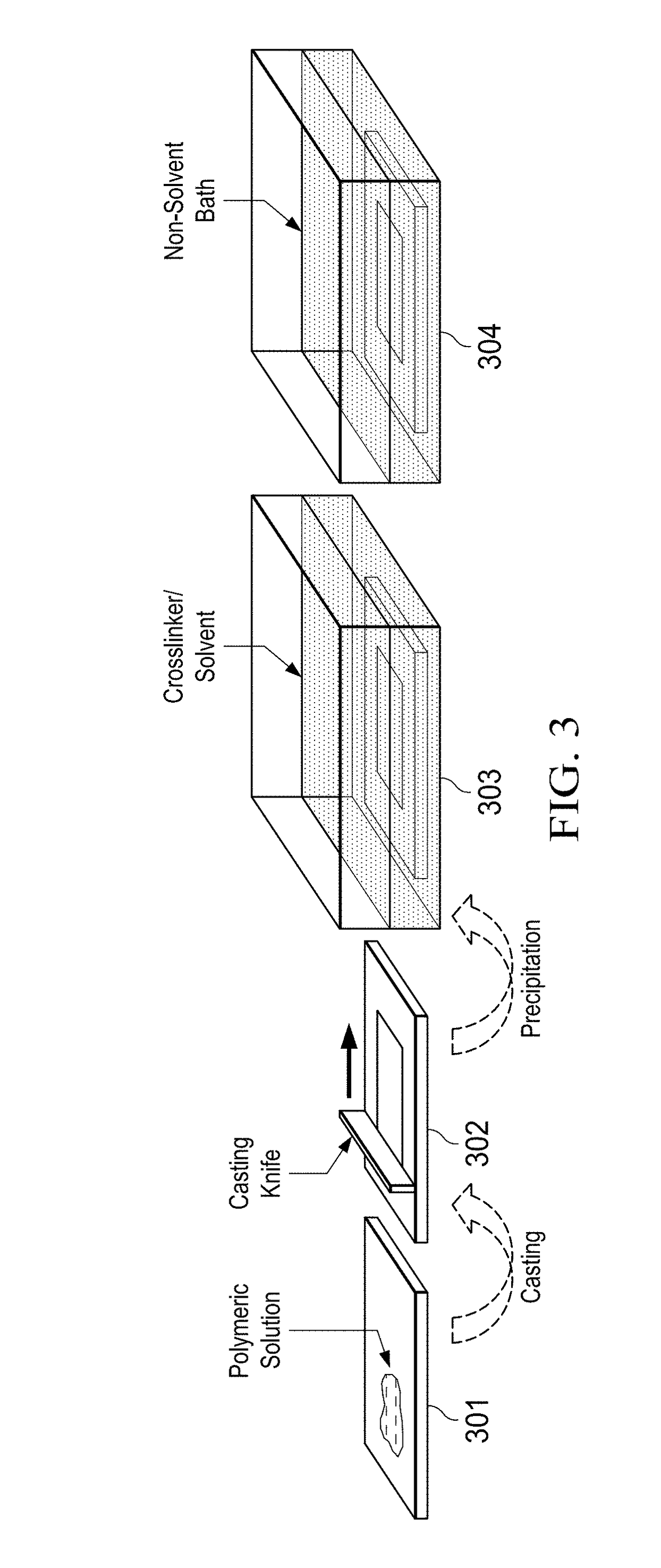Method of Making Reaction Induced Phase Separation Membranes and Uses Thereof
a technology of membrane, which is applied in the field of method and system for making reaction induced phase separation membrane, can solve the problems of losing some of the ability to move as individual polymer chains, and achieve the effect of efficient use of expensive materials
- Summary
- Abstract
- Description
- Claims
- Application Information
AI Technical Summary
Benefits of technology
Problems solved by technology
Method used
Image
Examples
example 1
Induced Phase Separation (RIPS) with DBX Crosslinker
[0088]FIG. 4 is a schematic of RIPS fabrication of membranes using Dibromo-p-xylene (DBX) (402) as crosslinker. In the chemical reaction schematic at the top of Example 1, the PTSC polymer (401) is crosslinked by DBX (402) to form a film of crosslinked PTSC polymer (403). The membranes were prepared using a polymeric solution of 15 wt % PTSC in DMSO as the casting solution. The resulting polymer solution was viscous and yellow in color. To eliminate any air bubbles in the solution, a two-hour settling time was allowed, avoiding possible imperfections on the membrane.
[0089]The general preparation process consisted of casting a 250 μm thick polymer film with a membrane casting knife by applying the polymer solution to a casting plate (404) and using a casting knife to spread the solution into a thin film (405). Following the casting step, the polymer film is immersed (406) in a solution of Dibromo-p-xylene (DBX) in DMSO to form the t...
example 2
Induced Phase Separation (RIPS) with Tr-X Crosslinker
[0094]FIG. 9 is a schematic of RIPS fabrication of membranes using a brominated triptycene (Tr-X) (902) crosslinker. In the chemical reaction schematic at the top of Example 2, the PTSC polymer (901) is crosslinked by Tr-X (902) to form a film of crosslinked PTSC polymer (903).
[0095]The membranes were prepared using a polymeric solution of 15 wt % PTSC in DMSO as the casting solution. The resulting polymer solution was viscous and yellow in color. To eliminate any air bubbles in the solution, a two-hour settling time was allowed, avoiding possible imperfections in the membrane.
[0096]The general preparation process consisted of casting a 250 μm thick polymer solution film with a membrane casting knife by applying the polymer solution to a casting plate (904) and using a casting knife to spread the solution into a thin film (905). Following the casting step, (906) the polymer film is immersed (906) in a 5 weight / weight % solution of...
PUM
| Property | Measurement | Unit |
|---|---|---|
| Fraction | aaaaa | aaaaa |
| Fraction | aaaaa | aaaaa |
| Time | aaaaa | aaaaa |
Abstract
Description
Claims
Application Information
 Login to View More
Login to View More - R&D
- Intellectual Property
- Life Sciences
- Materials
- Tech Scout
- Unparalleled Data Quality
- Higher Quality Content
- 60% Fewer Hallucinations
Browse by: Latest US Patents, China's latest patents, Technical Efficacy Thesaurus, Application Domain, Technology Topic, Popular Technical Reports.
© 2025 PatSnap. All rights reserved.Legal|Privacy policy|Modern Slavery Act Transparency Statement|Sitemap|About US| Contact US: help@patsnap.com



